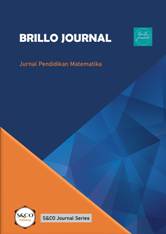Profil Kemampuan Pemahaman Matematis Siswa SMK Swasta Otomindo Jakarta pada Materi Sistem Persamaan Linear Dua Variabel
DOI:
https://doi.org/10.56773/bj.v1i2.11Keywords:
linear equation system, student profile, understanding abilityAbstract
Lesson plans are more focused on how to achieve goals and indicators. However, student ability profile has not become the main basic standard. Therefore, this research aims to describe the profile of students' mathematical understanding abilities. This research is a quantitative descriptive conducted on XI grade Otomindo’s vocational students in Jakarta. Data obtained from student achievement on the understanding ability test. Students' understanding is profiled according to the results of data analysis on their level and abilities based on achievement in mechanical, inductive, rational and intuitive indicators. The results of the study concluded that the profile of students' mathematical understanding abilities was dominated by inductive understanding abilities. It is because students are better able to apply formulas or concepts to simple or similar problems, but it is difficult to the rational and intuitive indicators. Students' mathematical understanding ability is included in the low category on two indicators, that is rational in terms of describing the truth of formulas and theorems, and intuitive in term of estimating the truth before analyzing further. While in the medium category, it is on mechanical indicators in terms of remembering and applying formulas routinely and calculating simply.
References
Abdullah, D. N. Y., & Zanthy, L. S. (2019). Analisis kemampuan pemahaman matematik siswa SMP dengan menggunakan pendekatan kontekstual. Journal on Education, 1(2), 207-214.
Afrilia, S., Sugita, G., & Rochaminah, S. (2022). Profile in Solving the Problems of Multiplying and Dividing in Algebra Form Students of SMP Negeri 18 Model SPMI Palu. Media Eksakta, 18(1), 37-42.
Anisa, R. N., Ruswana, A. M., & Zamnah, L. N. (2021). Analisis kemampuan pemahaman konsep matematis peserta didik SMP pada materi aljabar. J-KIP (Jurnal Keguruan dan Ilmu Pendidikan), 2(3), 237-242.
Budiarti, V., & Lestariningsih, L. (2018). Profil Penyelesaian Soal Trigonometri Ditinjau dari Kemampuan Matematika. Mosharafa: Jurnal Pendidikan Matematika, 7(2), 273-284.
Fillah, A., & Siswono, T. Y. E. (2018). Profil Kemampuan Penalaran Siswa dalam Menyelesaikan Masalah Matematika Ditinjau dari Kemampuan Matematika. MATHEdunesa, 7(2), 498-503.
Fitrah, M. (2018). Metodologi penelitian: penelitian kualitatif, tindakan kelas & studi kasus. CV Jejak (Jejak Publisher).
Kristanto, H. Y. W. (2019). Profil Pemecahan Masalah Sistem Persamaan Linear Tiga Variabel Siswa SMA ditinjau dari Perbedaan Jenis Kelamin. APOTEMA: Jurnal Program Studi Pendidikan Matematika, 5(2), 115-122.
Ramdani, M., & Apriansyah, D. (2018). Analisis Kemampuan Pemahaman dan Berfikir Kreatif Matematik Siswa MTs pada Materi Bangun Ruang Sisi Datar. Jurnal Cendekia: Jurnal Pendidikan Matematika, 2(2), 1-7.
Rukajat, A. (2018). Pendekatan penelitian kuantitatif: Quantitative research approach. Deepublish.
Sariningsih, R. (2014). Pendekatan kontekstual untuk meningkatkan kemampuan pemahaman matematis siswa SMP. Infinity Journal, 3(2), 150-163.
Silviana, D., & Mardiani, D. (2021). Perbandingan Kemampuan Pemahaman Matematis Siswa melalui Mood-Understand-Recall-Digest-Expand-Review dan Discovery Learning. Plusminus: Jurnal Pendidikan Matematika, 1(2), 291-302.
Syarifah, L. L. (2017). Analisis kemampuan pemahaman matematis pada mata kuliah pembelajaran matematika SMA II. JPPM (Jurnal Penelitian dan Pembelajaran Matematika), 10(2), 57-71.
Downloads
Published
How to Cite
Issue
Section
License
Copyright (c) 2022 Brillo Journal

This work is licensed under a Creative Commons Attribution 4.0 International License.
The authors agree that this article remains permanently open access under the terms of the Creative Commons Attribution 4.0 International License





